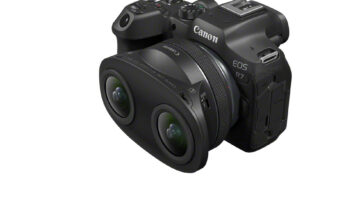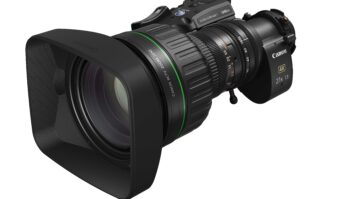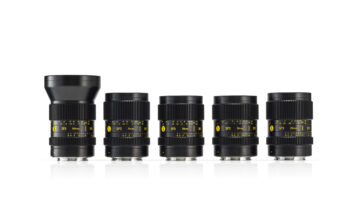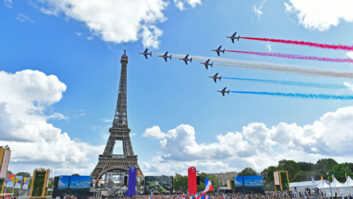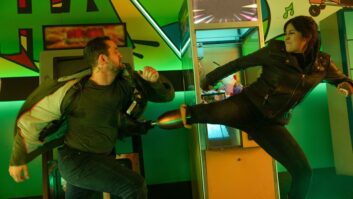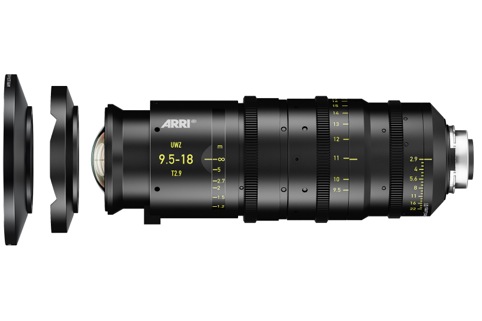
The biggest advance in lenses recently has been driven not by some new type of glass, but by larger camera sensors. David Fox reports
“The big change in lens requirements in recent years is due to the move from 2/3-inch 3-CCD cameras to large format, single sensor cameras,” says Stefan Czich, general manager, Broadcast and CCTV Products, Pyser-SGI (Fujinon’s UK and Ireland distributor).
“The growth in demand for 35mm PL glass has been predominantly driven by the camera manufacturers,” agrees Sebastian Kanabar, sales manager, Prokit, UK distributor for Schneider-Kreuznach’s Cine-Xenar III PL- or EF-mount prime lenses (available in 18, 25, 35, 50, 75 and 95mm focal lengths). “Six years ago there were a mere handful of cameras with a Super 35mm sensor. The Red One was the most affordable option, but even that involved an investment of tens of thousands of pounds. Alongside that were the ARRI D21 and the Sony F35, which required a greater investment.”
Today more than a dozen different video cameras have a ‘large sensor’. “For the lower value cameras, the Sony EA50, Canon C100, Blackmagic Cinema Camera, clients often opt to go for stills lenses, usually due to their budget. For the higher value systems clients appreciate the need for better glass. Around the launch of the Red One and ARRI Alexa, we saw a huge surge in demand for high quality cine glass. And in the last 24 months, with the launch of the Canon C300 and C500, and the Sony F5 and F55, this has just continued. Next year the launch of the Amira should maintain the demand,” adds Kanabar.
“The biggest change in lens technology is the resolution of the sensor,” agrees cameraman Steffan Hewitt, founder/director, Polecam, which supplies miniature lenses to fit the small cameras often used with its system.
But “it’s not always about pure resolution. Look at Cooke Optics. It’s not necessarily the best image, but it is the right image,” he adds. At 4K, cameras are starting to push the boundaries of traditional lens systems, although “you do find a lot of people going back to 16mm and other older lenses, because they actually were fantastic quality.”
Lens technology changes slowly, because (except for some low-end plastic lenses) it uses glass, which takes time. “To physically make a lens still takes just as long as it did 20 years ago,” says Hewitt. “If I order lenses today from Resolve Optics [which makes the world’s smallest zoom for miniature cameras, the Z10], it still takes 12 weeks, because it takes that long to grind glass.”
Just like the rest of the industry, the small cameras he often works with are moving to larger sensors – from 1/3-inch to 2/3-inch chips, “which means we can access a range of HD prime lenses that compliment the sensor,” he says. The tiny C-mount camera can be used with Kowa’s small new 10 megapixel prime lenses
“I’ve just come back from Dubai shooting the Ladies European Tour Golf Finals with a lovely wide-angle prime that really compliments the Antelope Pico high-speed minicam.” He used a Polecam and Pico with the new Kowa 5mm wide-angle (85º field of view) lens, which gave him “massive depth of field” at 280fps (which turned a two second shot of teeing off into 15 seconds of analysis – “the commentators loved it”). Single 2/3-inch sensors are now fitted to many small cameras (Indiecam, IO Industries, LMC and LMP), and the 5mm gave negligible distortion, compared to the “huge distortion” of the equivalent 2.5mm lens on a three-chip 1/3-inch camera. It also opens to F1.6, compared to F2.2 on the 2.5mm.
Prime directive
Kanabar believes that “the single biggest determiner for lens design in the next few years will be the advances in sensor technology. A higher resolution sensor will either require a higher lens resolution, or a lens able to cover a larger area. We’ve already seen 8K capture technologies tested, and if these come into the mainstream, lens resolution will have to increase exponentially. The Red Dragon sensor captures 6K, but over an image circle of 33.5mm, larger than the image circle of Super35, which is 31.5mm. There are a limited range of cine lenses that cover that sort of image size, and the ones that do, don’t have the ability to resolve 6K. If the Red trend continues, we’ll see lenses that have to cover an increasingly larger and more demanding sensor.”
The Cine-Xenar III lenses have a 31.5mm image circle suitable for sensors of up to about 5.5K, but Kanabar claims they “bear comparison to ARRI / Zeiss Ultra Primes or Cooke S4s. They have a similar build, size, weight, and image quality, but they are less than half the price. They also have that certain ‘look’ to them that is so cherished by many.”
Before being appointed distributors Prokit tested the range. “We knew from our experience with Red, just how demanding the lens requirements for 4K sensors can be. Glass that looks great on film, or a 2/3-inch sensor, gave unpredictable results on a digital chip. With the Cine-Xenars we were looking for glass that would resolve around 200lp/mm in the centre, be free of chromatic aberrations, and not breathe while focussing. Most of all, we were after glass that gave consistent, repeatable results on a digital sensor. We had calls from clients who, after upgrading their camera, were dissatisfied with the results they were getting from their 35mm stills glass. The Cine Xenars seemed to be a good option,” he says.
Schneider-Kreuznach has also developed a new range of full-frame primes, both for DSLR cameras with full-frame sensors and cine cameras. The Xenon T2.1 colour-matched lenses include seven fixed focal lengths: 25, 35, 50, 75 and 100mm, with a macro lens and further focal lengths to follow. They can be fitted with F, EF or PL mounts, and have: identical external dimensions and control positions; circular aperture with 14 blades; manual focus settings with a 300° angle of rotation; larger focus and distance scales for easier focussing even with greater distances, readable on both sides; and a M95 filter thread.
Canon’s new CN-E35mm T1.5 L F prime lens takes its range of EF Cinema primes to a total of six lenses. The CN-E35mm has been developed in response to strong demand from Cinema EOS users, and has a compact design that promises fast performance, which Canon believes makes it ideal for shooting in challenging low-light conditions.
The 35mm lens is designed for 4K production, with full frame coverage, and is colour matched to others in the range, as well as featuring the same form factor and uniform markings, making it easy to switch between lenses when on a shoot.
Cooke has extended its miniS4/i range of primes to include 40mm, 65mm and 135mm focal lengths, with a 21mm also in development. This will grow the range to ten lenses (the S4/i range has 18 lenses from 12mm to 300mm).
The miniS4/i lenses are all T2.8 (compared to the T2 of the S4/i and T1.4 of the 5/i range), which makes them considerably less expensive. “The real thing you are paying for is speed. The faster the lens, the higher the price, and with the increasing speed of cameras, T2.8 is often fast enough,” says Les Zellan, chairman and owner, Cooke Optics.
A new entry to the video market is Samyang Optics, which is known in the photography market for good quality lenses at reasonable prices. It now hopes to do the same for video with its V-DSLR cine lenses. The new 16mm T2.2 is €420, but should rival lenses costing at least double that from higher-end manufacturers for quality, claims its product manager, Piotr Madura.
The V-DSLR lenses are rack compatible with Follow Focus systems, and promise smooth, noiseless rotation of the aperture ring. They are available for Canon EF, Nikon F, Sony A and Sony E mounts. The Fish-eye (180° diagonal) 8mm T3.8 and the 16mm T2.2 both cover an APS-C/Super 35mm-size sensor, whereas the 14mm T3.1, and 24mm, 35mm T1.5 and 85mm (all T1.5) are full frame. Prices range from €379 for the 8mm to €650 for the 24mm. Future models will include a 50mm and a 135mm T1.8.
Super wide
The new Abakus 35mm Stadium Lens can bring an all-encompassing 202º view to Super35 sensor cameras. The £11,500, 9mm T2.8 PL-mount lens is very compact, and weighs just 1.6kg.
Although called a stadium lens, it is also useful in confined spaces, such as on a car dashboard, where it can show the view from both side windows, which has the effect of making the car look as if it is going faster.
“We’ve put in an internal filter holder, because you can’t put one on the curved lens at the front, however, there is a front protector you can fit, for use on helicopters or exposed locations, that uses a plastic that is really good optically and doesn’t attract dust,” says Abakus founder, Dr Ken Pollitt.
Also new for Super35 or full-frame 35mm sensors is the Abakus XL borescope/periscope, which will come with five lenses (10, 14, 20, 28 and 40mm) for about £40,000. The lenses incorporate controllable LED lighting for especially close-up subjects, with rear controls and a filter holder for accessibility.
Zoom with a view
ARRI’s new UWZ 9.5-18 Ultra Wide Zoom is claimed to be “the first super wide-angle zoom lens for the professional cine market.” The UWZ 9.5-18/T2.9, has an image circle of 33.7mm and uses patented technologies to overcome problems with previous wide-angle zooms.
Its optical performance is claimed to be comparable to, or even exceed, some high-end wide-angle prime lenses, and it is optimised for the requirements of VFX applications. Distortion is less than 1% at 9.5mm and less than 0.1% at 18mm, so that straight lines stay straight, even at close focus. A new multilayer, anti-reflective coating, means that flare and veiling glare are minimised, while exchangeable matte box interfaces ensure adequate sun protection whether filters are in use or not.
The telecentric optical design of the UWZ should give it highly uniform field illumination, while ARRI Lens Data System functionality outputs lens metadata for zoom, focus and aperture settings.
Fujinon has a range of 4K HK Premier cine lenses aimed at high-end cameras that covers 14.5mm to 400mm using four lenses with overlapping focal lengths, but of most interest to broadcast users is its new Cabrio range. This combines 4K PL-mount optics in a compact housing “with a zoom and focus servo unit that is familiar to ENG camera operators, a large rotational angle for zoom and focus, and T-stop markings that those from a film background expect,” says Czich.
“The servo is easy to detach and refit so the lenses may be used cine or video style. We have found that one of the key benefits is that using the servo package the lens can be used in OB or studio configuration, including remote control of iris settings. Fujinon and Pyser-SGI have been involved with tests of both 4K sports programmes and 4K high-frame rate recordings. Both of these will be key to successfully rolling out 4K production for broadcast.”
The new Cabrio ZK2.5×14 14-35mm/T2.9 wide angle is the latest addition to the range, which now covers 14-300mm with three lenses. Without the servo drive unit, the lens can be used in the traditional cinema manner, with or without external cine motors for zooming and focussing. The lens includes a Macro Function for shooting as close as 33cm.
Zeiss will release the third and widest of its Compact Zoom lens family, the CZ.2 15-30/T2.9, by NAB. It will join the lightweight CZ.2 70-200/T2.9 and CZ.2 28-80/T2.9 lenses, which proved so popular that Zeiss had to double its production capacity in order to reduce the lead time from six or seven months to three to four months.
“Our Compact Zoom family is the only cine-style zoom with full frame coverage [24x36mm], and we are the only ones with the interchangeable mount system [for PL, EF, F, MFT and E mounts],” claims Helmut Lenhof, Zeiss product manager for Digital Cinema. Despite the fact that lenses get bigger as their image area increases “this is still light [2.5kg] and compact,” he adds. Full frame coverage means they can also be used on DSLRs, and they can create a sweet spot effect and a uniformity of illumination when used on Super35 sensors.
Price for the CZ.2 15-30 should be similar to the other Compact Zooms (about €14,900) and they will be exactly colour matched (as they are with the ARRI/Zeiss Master Prime and ARRI/Zeiss Ultra Prime lenses). The CZ.2 15-30 will replace the discontinued Lightweight Zoom LWZ.2.
The new Angénieux Optimo 25-250 DP T3.5 zoom lens may be more affordable than the 28-340mm and 24-290mm Optimo DP zooms, but it is comparable in quality, significantly lighter (at 7kg instead of 11kg) and more compact. “Optically it is really high performance, and mechanically it is very strong,” claims Jean-Yves Le Poulain, Thales Angénieux product manager for cinema/TV lenses.
There is 32mm sensor coverage with “close to 6K” resolution. It meets the DCI specification for 4K projection, so is very flat. Minimum focus is 1.2m. It comes with a PL mount as standard, but can be fitted with Panavision, Canon EF or Nikon F mounts.
It boasts good flare correction, so it can work without a shade, while filters, even gels, fit at the back of the lens at a point where dirt on the filter won’t be critical. There is also a Cooke /i technology interface for metadata. The lens will cost €39,000 when it ships next month.
Mount up
Schneider Optics’ new 1.4x Century Extender for PL-mount cameras can increase the range of a lens by 40% with just a single F/stop loss in light.
The Century 1.4x MK II PL to PL Extender mounts between a PL-mount camera and lens, and allows zooming while maintaining focus. It also allows mount clearance of up to 14mm from the PL mount flange.
Schneider Optics has also introduced a new In-Camera Filter System developed by Clairmont Camera for the ARRI Alexa. It uses custom assemblies that hold interchangeable Schneider filters in front of the Alexa’s sensor.
Denny Clairmont, CEO of the rental house, says the camera’s high light sensitivity (600 ISO and beyond), makes use of neutral density filters particularly important. “One of the things cinematographers appreciate most about the ARRI Alexa is the excellent light sensitivity. Working at higher ISO ratings can lead to lots of ND if you want to shoot wide open.”
The kit includes a magnetic filter holder that replaces the Alexa’s light baffle. It also comes with shims (to precisely compensate for the focus change resulting from the behind the lens filter), a filter installation tool, and seven mounted Schneider ultra precision multi-coated in-camera filters: Clear, IRND .3, .6, .9, 1.2, 1.5 and 1.8. When no filtering is needed, a clear filter is used to maintain focus, and filters can be changed in minutes.
The kit can be used with most PL lenses but is not compatible with Zeiss T2.1 16mm, 24mm, 32mm, ARRI Macro 16mm, 24mm, or 32mm, or the Cooke Series II and III 18mm, 25mm and 32mm lenses. Lens extenders may also interfere with the filters.
Anamorphics give digital personality
Anamorphic lenses have seen a surge in popularity recently, with the introductions of new lenses from ARRI/Zeiss, Cooke and Angénieux.
Cooke Optics is introducing seven Anamorphic/i lenses: 25mm, 32mm, 40mm, 50mm, 75mm, 100mm and 135mm, all T2.3. “There’s a huge demand for anamorphics. We have orders stretching long into the future,” says Zellan.
“Digital makes anamorphic use a lot easier than film did,” but digital can also look boring, while anamorphic adds texture and feeling, he argues. “One reason Cooke lenses remain popular is that they have a personality that people like.”
It is working with Thales Angénieux to ensure that both their ranges of anamorphic lenses are compatible. “Cooke primes and Angénieux zooms have always complemented each other in terms of look and colour. They are frequently used together on feature films,” says Zellan.
The Angénieux anamorphic zooms, starting with a 56-152mm T4, will have a unique optical design combining spherical and cylindrical elements in the same group to deliver exceptional sharpness and low distortion. “The entire line will perfectly match with the new Cooke primes and will be friendly, usable, compact and lightweight,” says Pierre Andurand, CEO and president, Thales Angénieux. Both ranges will be available this year.
There will soon be seven ARRI/Zeiss Master Anamorphic lenses available. Four have already started shipping (the MA35, 50, 75 and 100mm), with the MA40 and 60 due in February, and the MA135 in April. They were designed and built by Carl Zeiss to meet ARRI’s specifications.
The low-distortion lenses have a fast T-stop of T1.9, for shallow depth-of-field work, which can be used “with any focal length, at any distance, without sacrificing image quality; gone are the days when anamorphic lenses had to be stopped down to T4 to get an acceptable result,” says Stephan Shenk, ARRI’s general manager, camera division.
Skin tone rendition is promised to be “pleasing and film-like, while colours are crisp and natural.” Image quality should be consistently high throughout the frame, with no drop-off towards the corners. The lenses also have 15 iris blades, to give a pleasing look to out-of-focus highlights.
Measure for measure
Cooke has also introduced a new Metrology line of testing equipment “to raise industry standards.” Its first model is a new lens test projector that is designed for today’s fast lenses and is so bright that it can be demonstrated in daylight (although it is dimmable), making it much easier to discern flaws and artefacts in fast lenses. Many current projectors cannot pass a beam correctly through lenses that are faster than T2.
It has an interchangeable lens mount to work with any lens and can be used to check lens performance, match lenses, and set the lens up correctly before it goes out on a job.
There will also be a T-Stop Machine, “for measuring how accurate the T-stops on a lens are, to make sure it’s really a T2 and not a T2.4,” says Zellan. It too will work with any brand of lens.
On the box
Fujinon’s new XA55x9.5BESM HD telephoto box lens is “the first in its class to include an optical image stabiliser. This will allow for rock steady images to be produced even when the camera is moving due to wind or an unsteady base, this feature has only been found in longer, more expensive lenses until now,” says Czich.
The 2/3-inch format 55x zoom is fitted with an integral camera/lens support, a cost saving compared to buying a separate cradle. “This integral cradle also reduces camera-rigging times. With quick rigging and competitive pricing this lens is aimed at areas such as religious broadcasts, concerts, party conferences and sports events,” he adds.
The lens has a 16-bit encoder to output precise zoom, focus and other lens data, and can be used with virtual systems that combine CG images with live pictures. Its focal length is 9.5mm to 525mm (plus 2x extender). Maximum relative aperture is F1.7 up to 308mm and F2.9 at 525mm, minimum object distance is 3m, and the lens weighs 24.8kg.
www.abakus.co.uk
www.angenieux.com
www.ARRI.com
www.canon-europe.com
www.cmotion.eu
www.cookeoptics.com
www.fujinon.de
www.LiveMotionConcept.de
www.polecam.com
www.prokit.co.uk
www.pyser-sgi.com
www.samyang-europe.com
www.schneideroptics.com
www.zeiss.com/cine
Lenses square up to inertia
Metadata has been an approaching technology in lenses for several years, but even when the lenses can deliver it, it is either not being captured or nothing is being done with it in post. Cooke Optics is now working with other companies to make lens data, such as its /i2 Technology, more relevant to what users do in post and to make it simpler to capture.
“/i2 Technology is the next generation of our intelligent metadata system, augmenting normal lens metadata (iris, focus) with the inertial movement of the lens. So, if you are tracking a shot and someone walks in front of the marker, the inertial data software will automatically find that track,” says Les Zellan, chairman and owner, Cooke Optics.
Cooke has worked with Pixel Farm, with its PF Track, “to assist them in either making a solvable track more accurate or, if it loses the track, making the two ends meet,” he explains. “This is a big issue. Tracking software is very accurate on 97% of shots, but on the 2-3% it can be expensive.”
Cooke is also working with Codex Digital on recording the metadata. “Although there are several /i2 cameras (ARRI, Sony and Red), they all treat the data differently. They all can record our lenses, but what they do with it is out of our control.” To avoid this data going astray, Codex is also making a small stand-alone metadata recorder that will plug into the lenses and also record timecode. It will also be usable with non /i2 cameras.
Broadcast control for cine lenses
New ENG adapters from cmotion allow operators to use familiar broadcast controllers for focus and zoom when using external motors mounted on cine style lenses. The adapters create an interface between Canon and Fujinon broadcast style controllers and components from cmotion’s new and existing lens control system.
When used with some broadcast cameras and cmotion’s camin, the iris motor can be controlled automatically by the camera’s internal sensor. It is also possible to synchronise this for 3D broadcast.
It’s new cforce motors can also be daisy chained and then connected to an ENG adapter through a single cable.
When using systems such as Telecast Fibre, the iris scale can also be controlled from an OB truck or studio using a cvolution knob solo.
Also new is the Compact LCS, cmotion’s first budget lens control system, which can offer precision control for up to three motors, whether wireless or hardwired, through an ergonomic, easy to use hand unit.
It uses new cforce motors developed with ARRI that are claimed to provide outstanding performance while being virtually silent (less than 20dB).
Field of view: There’s an App for that
LMC’s new LensView App uses an iPhone to simulate a camera’s field of view so you can see what all Fujinon and Canon broadcast lenses will look like for any 2/3-inch or 1/3-inch broadcast camera.
“When you use LensView during your site survey, you will not have any headaches when you ARRIve on site at your actual production, because you already know what your cameras are going to see,” explains TV director, Felix Marggraff, CEO of LMC (LiveMotionConcept).
He promises that the app, which costs €8.99/£6.99/$9.99, will be updated with new lenses as they emerge and that data for lenses from Angénieux, as well as ARRI, GoPro, Phantom, Red and other cameras “will follow soon.”
Other updates promised include: comparison screen shots within the app (currently you can take a screenshot that is saved to the camera roll); and forwarding of screenshots straight from the app – by email, mms, etc. “We want to keep the app simple though, as we all know that during a site survey you want quick results and easy operations,” he adds.
